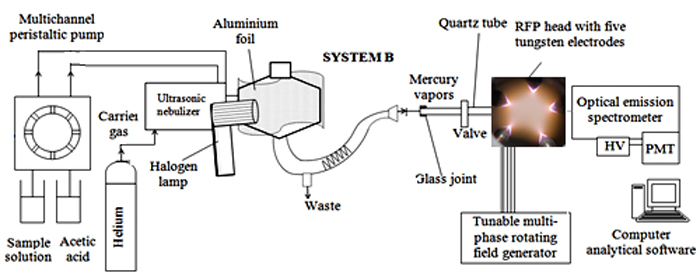抄録
A new sensitive method for total mercury determination in reference materials using a 5-phase digitally controlled rotating field plasma source (RFP) for optical emission spectrometry (OES) was developed. A novel synergic effect of ultrasonic nebulization (USN) and ultraviolet-visible light (UV-Vis) irradiation when used in combination was exploited for efficient Hg vapor generation. UV- and Vis-based irradiation systems were studied. It was found that the most advantageous design was an ultrasonic nebulizer fitted with a 6 W mercury lamp supplying a microliter sample to a quartz oscillator, converting liquid into aerosol at the entrance of the UV spray chamber. Optimal conditions involved using a 20% v/v solution of acetic acid as the generation medium. The mercury cold vapor, favorably generated from Hg2+ solutions by UV irradiation, was rapidly transported into a plasma source with rotating field generated within the five electrodes and detected by digitally controlled rotating field plasma optical emission spectrometry (RFP-OES). Under optimal conditions, the experimental concentration detection limit for the determination, calculated as the concentration giving a signal equal to three times the standard deviation of the blank (LOD, 3σblank criterion, peak height), was 4.1 ng mL−1. The relative standard deviation for samples was equal to or better than 5% for liquid analysis and microsampling capability. The methodology was validated through determination of mercury in three certified reference materials (corresponding to biological and environmental samples) (NRCC DOLT-2, NRCC PACS-1, NIST 2710) using the external aqueous standard calibration techniques in acetic acid media, with satisfactory recoveries. Mercury serves as an example element to validate the capability of this approach. This is a simple, reagent-saving, cost-effective and green analytical method for mercury determination.



